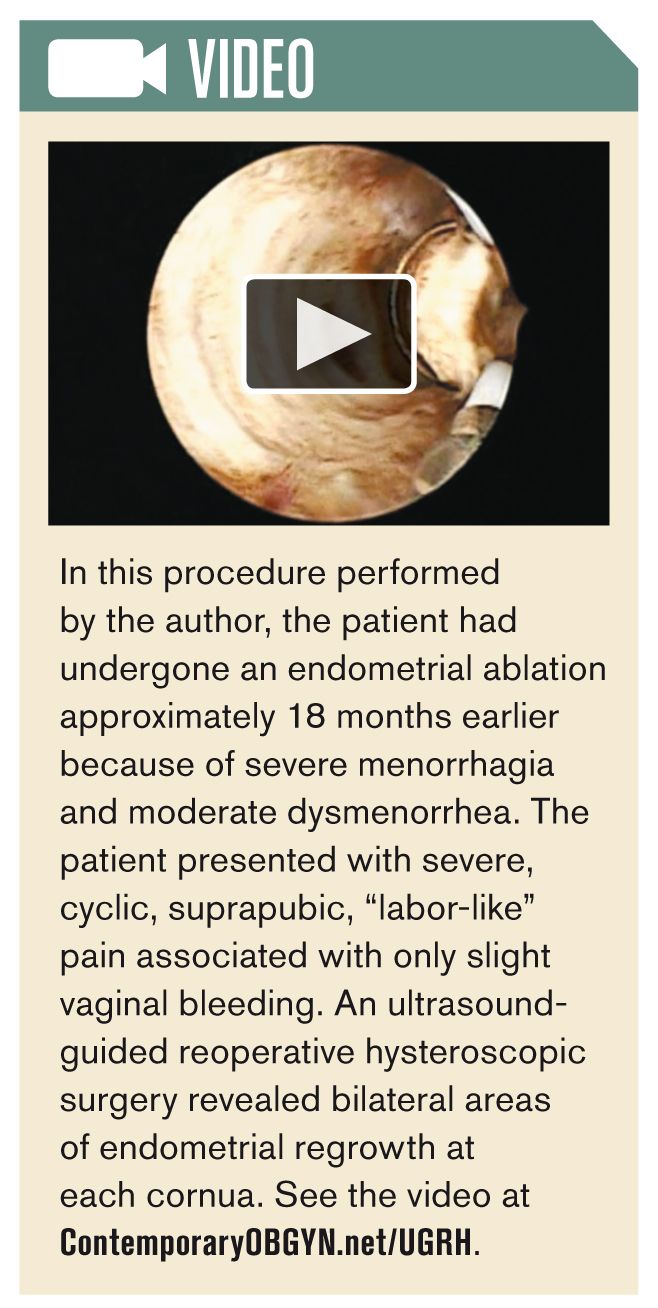The MIGS approach to fixing failed endometrial ablation
When endometrial ablation fails, ultrasound-guided reoperative hysteroscopic surgery helps patients avoid hysterectomy.

Dr. Wortman is Director, Center for Menstrual Disorders, Rochester, New York, and Clinical Associate Professor of Gynecology, University of Rochester Medical Center.
He reports receiving honoraria from Hologic.

The introduction of resectoscopic endometrial ablation (REA) in 1981 ushered in an important era in minimally invasive management of abnormal uterine bleeding (AUB) unresponsive to medical management.1 Although REA gained only limited acceptance in the gynecologic community, the introduction of non-resectoscopic endometrial ablation (NREA) techniques was widely embraced. In 2008 alone, some 312,000 NREA procedures were performed in the United States.2
Despite quite encouraging initial results with endometrial ablation (EA), a 2007 ACOG Practice Bulletin noted that 24% incidence of hysterectomy within 4 years after EA.3 One 8-year follow-up of 3681 women noted that delayed complications continued to increase throughout the surveillance period.4
The delayed complications of EA manifest themselves in 1 of 3 ways: persistent or recurrent vaginal bleeding, cyclic pelvic pain, and inability to adequately assess the endometrium in women who later require sampling.5
Persistent or recurrent vaginal bleeding-occurring months or years following EA-has been attributed to inadequate endometrial destruction,6 unsuspected deep adenomyosis,7 or the occurrence of new pathology-myomata, polyps, endometrial hyperplasia, or cancer. Pelvic pain is generally cyclic and has been attributed to cornual and central hematometra as well as to postablation tubal sterilization syndrome (PATSS).5 McCausland et al noted that the etiology of cyclic pelvic pain “following both resectoscopic and nonresectoscopic endometrial ablations is due to the intrauterine scarring and contracture that can occur following the procedure.”5 Inability to adequately assess the uterine cavity is an under-reported delayed complication following EA. Ahonkallio et al demonstrated that endometrial biopsies failed in 23% of women with previous EA and were likely unreliable in many of the remaining patients because endometrium is often trapped in the sequestered cornual regions.8 Any of these delayed complications is a sufficient reason to perform a hysterectomy.
Several authors have reported “repeat” or “reoperative” EA procedures. Gimpelson was able to successfully treat 16 women who underwent reoperative hysteroscopic surgery (RHS) with either Nd:YAG laser or electrosurgical techniques-avoiding hysterectomy in all subjects during the surveillance period.9 The largest series of RHS was reported by Istre et al, who offered RHS to 118 women and were able to avoid hysterectomy in 72% of subjects during a mean follow-up period of 22 months.10 In 2001, the author reported performing ultrasound (U/S)-guided RHS on 26 women-mostly REA failures-88.5% of whom avoided hysterectomy during a mean follow up period of 23.2+22.7 months.11 More recently the author reported the results of U/S-guided reoperative hysteroscopy (UGRH) for managing NREA failures in 50 women, 88.9% of whom avoided hysterectomy during a mean follow-up period of 18.1 months.12
My experience suggests that combined use of U/S guidance and hysteroscopic resection techniques provide 2 distinct advantages over other methods of RHS. First, U/S enables access to areas of the uterus that are sequestered by dense synechiae, enabling one to locate areas of hematometra, endometrial regrowth, and leiomyomas in a setting with few intrauterine landmarks. Second, hysteroscopic resection provides ample tissue for histologic analysis-especially crucial in the evaluation of women with postmenopausal bleeding.
Here I will summarize patient selection, operating room set-up, and technique for, and results associated with UGRH.
Preoperative evaluation
History
Often the diagnosis of EA failure is straightforward: a history of gradually increasing vaginal bleeding, worsening cyclic pelvic pain, or both. The pain-typically lasting 3–4 days-may be unilateral, bilateral, or suprapubic, and is often described as “sharp,” “stabbing,” “cramping,” or “labor-like.” Diagnostic delay is often considerable when these symptoms are not accompanied by vaginal bleeding.
Physical examination
The pelvic examination-best performed while the patient is symptomatic-often reveals exquisite uterine tenderness, sometimes accompanied by adnexal tenderness. Adnexal tenderness is far more common than is PATSS, which often signifies cornual hematometra.
Sonographically assisted pelvic examination
Sonographically assisted pelvic examination allows a physician to correlate U/S findings with physical signs. The timing of this exam is critical, because hematometra are often evanescent and may disappear during the early proliferative phase of the cycle. The presence of a central or cornual hematometra (Figure 1) is an important finding and is strongly associated with cyclic pelvic pain. However, the absence of a demonstrable hematometra does not exclude the diagnosis of EA failure. U/S also may be useful for diagnosis of PATSS. Other assessments-endometrial biopsy, saline infusion sonography, hysterosalpingography, and magnetic resonance imaging-have been shown to have little merit in the evaluation of women who present with delayed-onset EA complications.
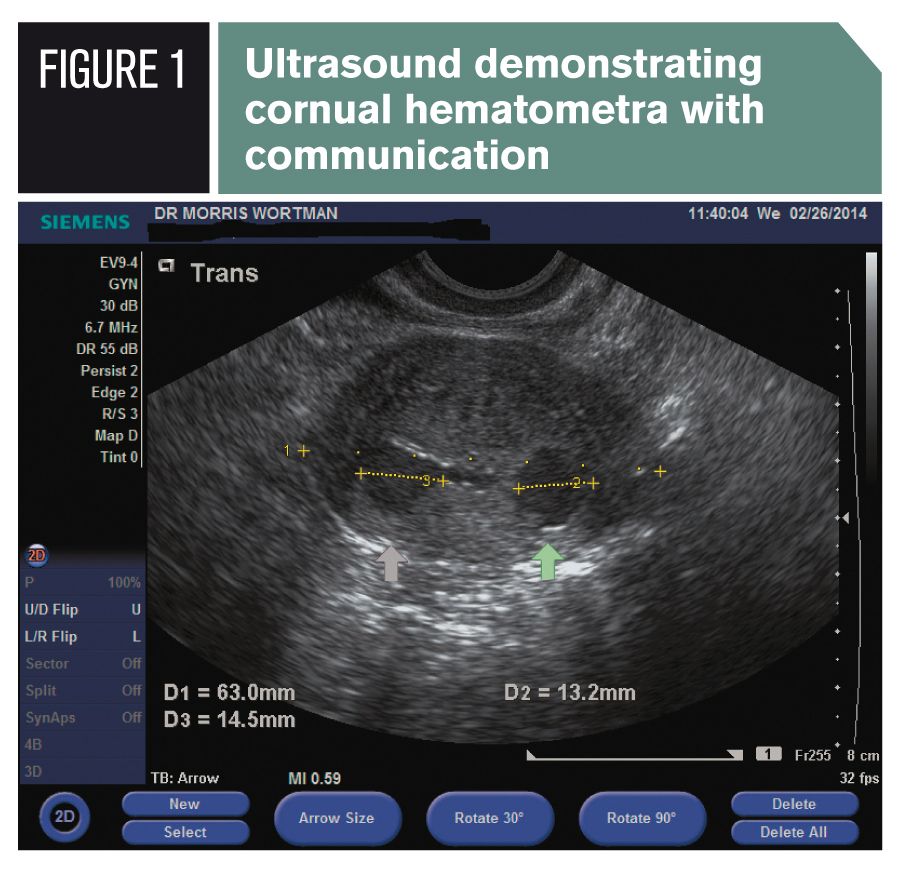
Patient selection
A physician who suspects an EA failure must consider several factors before offering the patient RHS. Although evidence-based guidelines are lacking, I believe that several patient selection criteria may be helpful (Table).
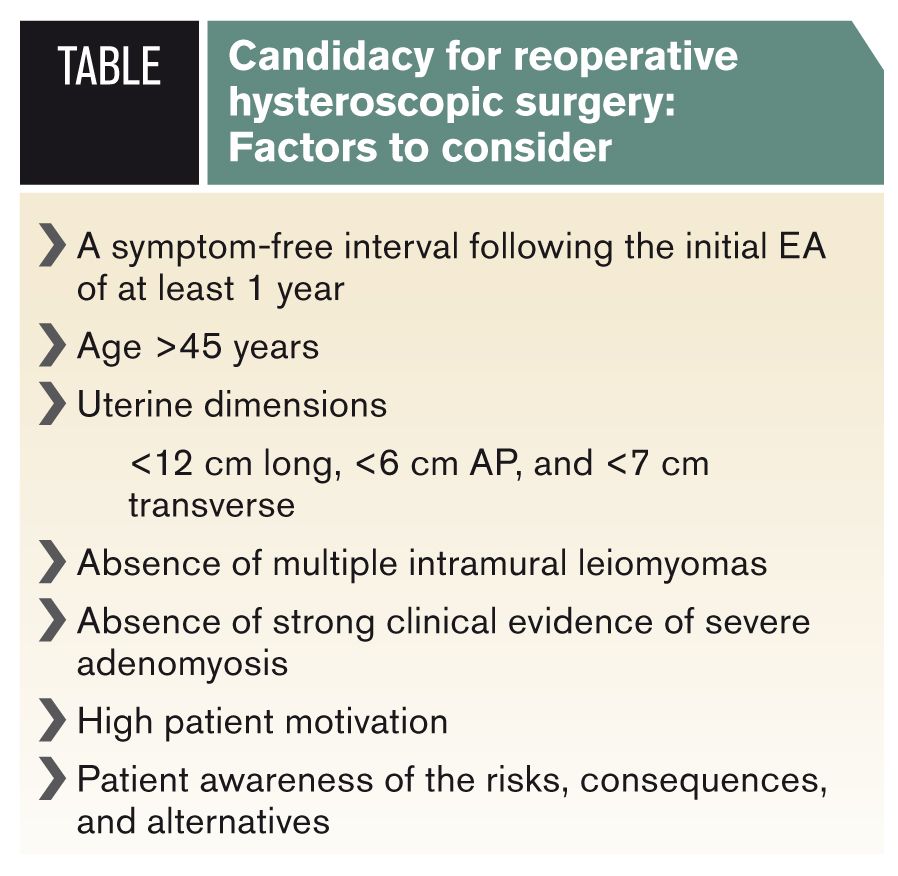
Patient preparation
In order to optimize sonographic imaging, women undergoing UGRH should avoid gonadotropin-releasing hormone agonists, although they may be necessary for management of symptoms if a significant operative delay is anticipated. We routinely perform sonographically guided cervical dilation and place a 3- to 4-mm laminaria japonica the day before the scheduled procedure, generally with adjuvant use of minimal sedation. Significant stenosis at the internal os and well beyond it should be anticipated. Patients should be given prescriptions for non-steroidal anti-inflammatory drugs or opiates because cramping following laminaria placement is often significant.
Equipment and setup
The equipment and personnel utilized for RHS are identical to what most surgeons already use for routine operative hysteroscopy. Some of my additional preferences include:
Resectoscopes and reconfigured loops
Most procedures are performed using a 22F or 26F unipolar resectoscope. We use a 13F pediatric resectoscope for management of the small postmenopausal uterus or when severe cervical stenosis precludes passage of even the smallest dilator. The electrosurgical loops we use vary from 90 degrees to 180 degrees and we often reconfigure them to appropriate shapes to facilitate exploration of the cornua (Figure 2). Bipolar resectoscopes can be used in selected cases where larger fluid deficits may be an issue.13
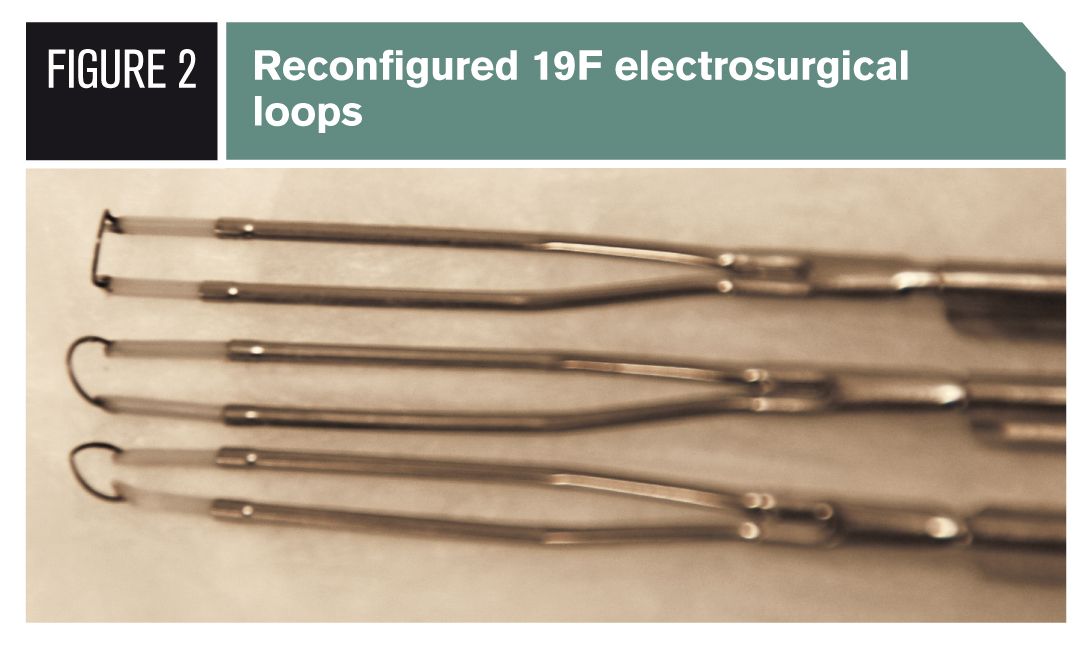
Electrosurgical generator
Our operating room (OR) is equipped with an Autocon II 400, enabling use of both unipolar and bipolar electrosurgery. Unipolar electrosurgery is generally performed at 140 W of C-Cut effect 4, during the resection phase and 120 W of forced coagulation current, effect 4, for the coagulation portion of the procedure. Whenever bipolar electrosurgery is used, a saline C-cut, effect 5, is employed.
Ultrasound machine and guidance
We currently use a Siemens Acuson X150 equipped with a variable-frequency abdominal transducer. Our operating room is fitted with 2 side-by-side monitors that facilitate simultaneous sonographic and hysteroscopic views (Figure 3).
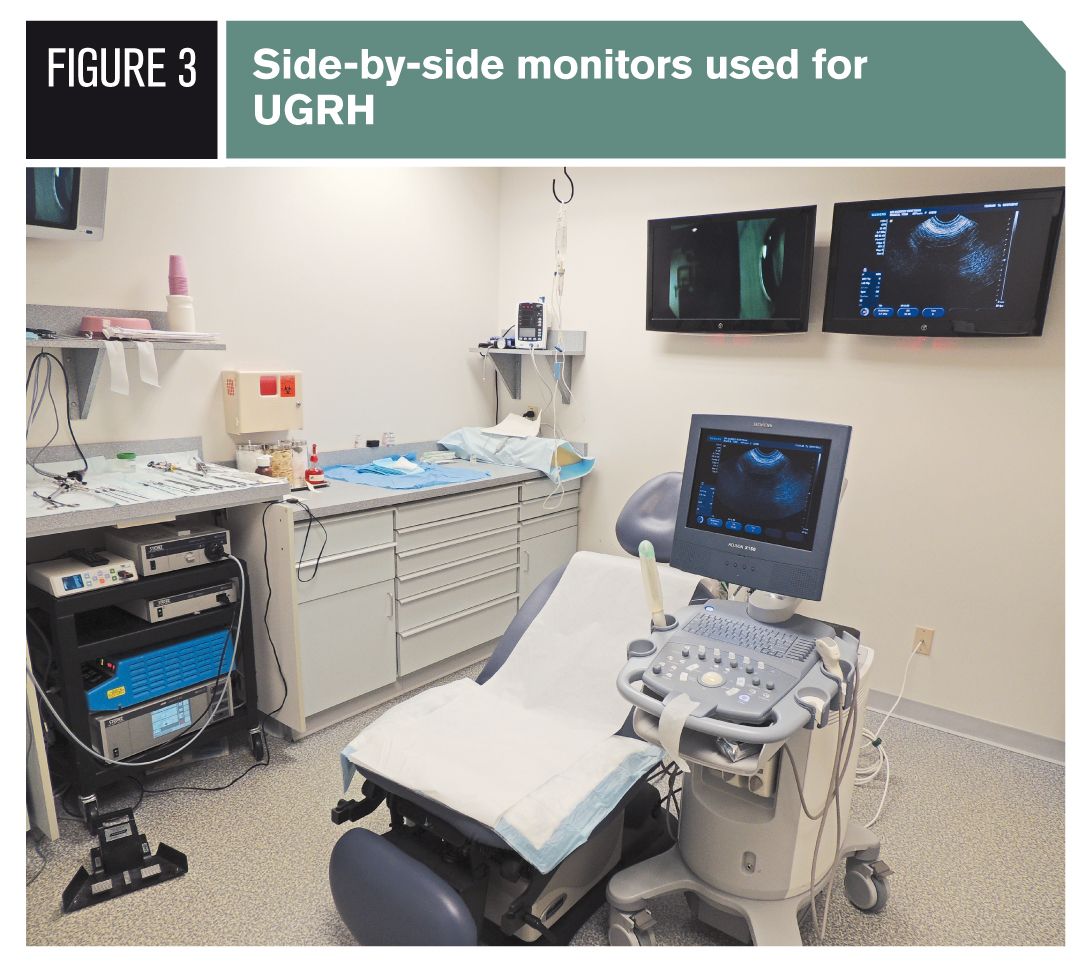
The remainder of the setup is standard for nearly all operative hysteroscopies and includes a video tower, light source, and digital recording system. Careful coordination is necessary so that the sonographer has adequate access to the patient and that monitors are positioned to allow hysteroscopic and ultrasound monitors to be viewed simultaneously.
The procedure
Patients are asked to arrive in the OR with a full bladder in order to avoid catheterization. Although antibiotic prophylaxis is not generally warranted for hysteroscopic procedures, because of the complexity of these procedures, we administer ampicillin 2 g or clindamycin 300 mg intravenously for prophylaxis. The patient is placed in lithotomy position prior to induction of anesthesia to ensure her comfort. After induction of anesthesia or-for office-based procedures-moderate sedation, a vaginal speculum is inserted and the previously placed laminaria japonica and sponges are removed prior to the vaginal prep.
A vasopressin solution containing 2.5 units/20 mL saline is injected intracervically at the 3 o’clock and 9 o’clock positions. Aspiration is recommended prior to injection in order to avoid an inadvertent intravascular injection. Mechanical dilation to 8 mm or 10 mm is accomplished under sonographic guidance with Hegar dilators prior to introduction of a 22F or 26F unipolar resectoscope. Glycine 1.5% or saline 0.9% is delivered at sufficient pressure to permit adequate uterine distention and flow. The net fluid absorption is carefully monitored and we are careful to perform all procedures within published fluid management guidelines.13
Approach to the tubular cavity
Often the initial hysteroscopy reveals a short tubular cavity with little or no obvious evidence of active endometrium. Often, dense synechiae are present-especially if there has been a long interval since the original EA. Tubular cavities often coexist with areas of cornual or central hematometra that may or may not be evident on U/S guidance. In the absence of sonographically demonstrable hematometra, dissection begins-using a standard resectoscopic electrosurgical loop-on either the anterior or posterior walls (Figure 4), enlarging the cavity and allowing the continuous flow of low-viscosity fluid. As the cavity distends, both hysteroscopic and sonographic visualization are enhanced.
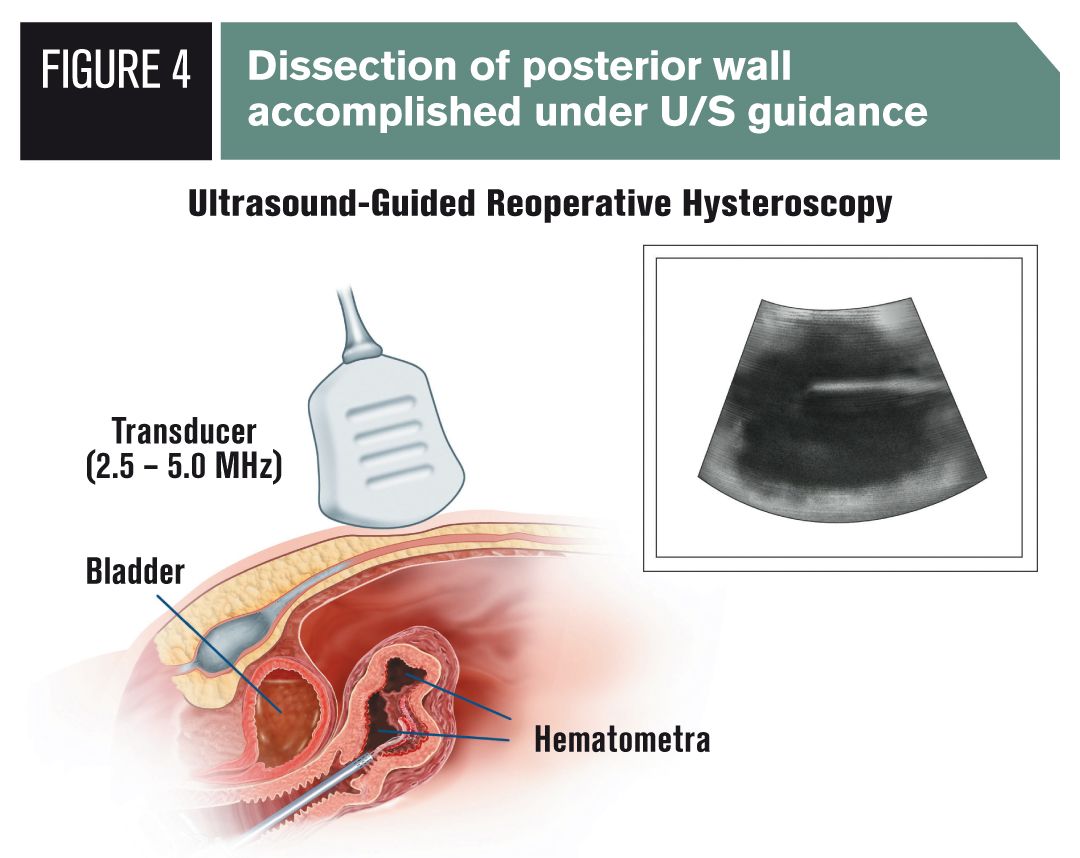
When a central hematometra lies adjacent to the tubular cavity, dissection is carried out into the hematometra (Figure 5), after which 3 mm–5 mm of tissue is removed beneath the endometrial basalis. If a central hematometra is not identified, the dissection proceeds in a cephalad direction to within 10 mm of the uterine apex and then radially in all directions in order to explore the entire uterus to within 5 mm–10 mm of its serosal surface (Figure 6). In the presence of cornual hematometra we gently explore the cornual regions, if possible, within 2 mm–4 mm of the serosa. Finally, the procedure is completed by coagulating the exposed myometrium with a 2-mm or 3-mm ball-end electrode at 120 watts of coagulation current.

Lastly, unlike resectoscopic endometrial ablation or resection-for which surgeons often develop their own surgical sequences to accomplish their goals-there is no predetermined order for RHS. The course of each procedure is dictated by the variable hysteroscopic and sonographic findings.
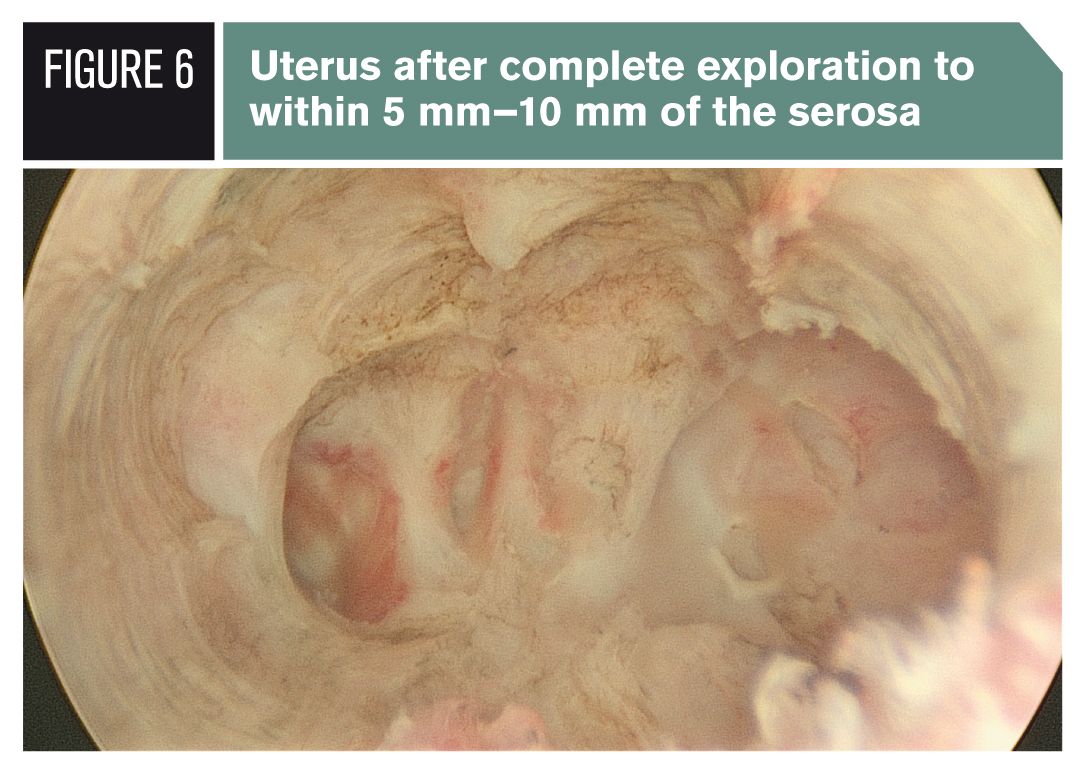
Approach to the well-developed uterine cavity
Well-developed cavities are often associated with early EA failures-within 6 months of the procedure. These cavities are generally devoid of the dense intrauterine synechiae and often contain submucous leiomyomas, large uterine septa, or substantially enlarged uterine cavities (sagittal dimensions ≥11 cm or transverse dimensions ≥8 cm). Septa, when present, generally require at least partial removal in order to facilitate adequate treatment of the uterine cornua and tubal ostia. When present, submucous leiomyomas must be resected in order to gain full access to the uterine cavity. After these initial measures, a standard endomyometrial resection is performed.14 The goal of UGRH is removal of at least 4 mm of tissue beneath the basal layer of the endometrium, a depth that is reduced to 2 mm–3 mm at the cornual regions. At the close of the procedure, deep coagulation of the myometrium is accomplished with a 2-mm or 3-mm ball-end electrode at 120 watts of coagulation current.
Ultrasound guidance-dynamic scanning
U/S guidance is provided by performing dynamic scanning-a combination of sagittal and transverse scanning to ascertain that the resectoscope is, at least initially, advanced in the midline of the uterus. This is critically important in the absence of traditional intrauterine landmarks. This technique is used to bring the loop to desired areas of interest and is especially important in RHS of the tubular cavity. Sagittal scanning is most appropriate when resecting continuous strips of tissue in the long axis. It is often used preferentially to define the minimal distance between the operative site and the serosa of the anterior, posterior, and lateral walls. Transverse scanning is often used as a “cross-check” when operating on the lateral walls and in the cornual regions. Coordination between sonographer and surgeon is imperative in order to maintain optimal safety and guidance to areas that are sequestered by intrauterine scarring.
Results
UGRH was first reported by this author in 2001.11 In a series of 26 women-predominantly failures of hysteroscopic EA or resection techniques-hysterectomy was avoided in 88.5% during a mean follow-up of 23.2 +22.7 months. There were no complications associated with the procedure.
In a more recent series of 50 women presenting with delayed complications following a variety of NREA or “global” techniques, UGRH was completed without any intraoperative or perioperative complications.12 Eighty percent of subjects experienced no further cyclic pelvic pain and were amenorrheic, oligomenorrheic, or experienced occasional scant flow. Two women (4%) reported amenorrhea with mild cyclic pain and another 2 (4%) reported amenorrhea with moderate cyclic pain. In all, 89.8% of subjects were very satisfied with their outcomes and were able to avoid further surgery during this limited follow-up period.
Summary
UGRH is an advanced and specialized minimally invasive hysteroscopic technique accomplished under sonographic guidance and has the capacity, in our hands, to significantly reduce the need for hysterectomy in women who have experienced delayed complications following EA. UGRH requires a team that includes an experienced hysteroscopist and a sonographer trained to provide U/S guidance. UGRH can produce rewarding results with very low morbidity and is no more challenging than many of the complex procedures performed by those specializing in other branches of minimally invasive gynecologic surgery. As in the case of any new procedure, it requires commitment to learning a new technique in the secure environment of a supportive team.
References
1. Goldrath MH, Fuller A, Segal S. Laser photovaporization of endometrium for the treatment of menorrhagia. Am J Obstet Gynecol. 1981;140:14–19.
2. Hologic. News release. One million patients choose Hologic’s NovaSure system over hysterectomy. http://investors.hologic.com/index.php?s=43&item=420. Accessed March 2, 2014.
3. Munro MG. ACOG Practice Bulletin: endometrial ablation. Obstet Gynecol. 2007;109:1233–1247.
4. Longinotti MK, Jacobson G, Hung Y, et al. Probability of hysterectomy after endometrial ablation. Obstet Gynecol. 2008;112:1214–1220.
5. McCausland AM, McCausland VM. Long-term complications of minimally invasive endometrial ablation devices. J Gynecol Surg. 2010;26:133–149.
6. Turnbull LW, Jumaa A, Bowsley SJ, et al. Magnetic resonance imaging of the uterus after endometrial resection. British J Obstet Gynecol. 1997;104:934–938.
7. McCausland AM, McCausland VM. Depth of endometrial penetration in adenomyosis helps determine outcome of rollerball ablation. Am J Obstet Gynecol. 1996; 174:1786–1793.
8. Ahonkallio SJ, Liakka AK, Martikainen HK, et al. Feasibility of endometrial assessment after thermal ablation. Eur J Obstet Gynecol Reprod Biol. 2009;147:69–71.
9. Gimpelson RH, Kaigh J. Endometrial ablation repeat procedures case study. J Repro Med. 1992;37:629–634.
10. Istre O, Langebrekke A. Repeat hysteroscopic surgery reduces the hysterectomy rate after endometrial and myoma resection. J Am Assoc Gynecol Laparosc. 2003;10:247–251.
11. Wortman M, Daggett A. Reoperative hysteroscopic surgery in the management of patients who fail endometrial ablation and resection.
J Am Assoc Gynecol Laparosc. 2001;8:272–277.
12. Wortman M, Daggett A, Deckman A. Ultrasound-guided reoperative hysteroscopy for managing global endometrial ablation failures. J Minim Invasive Gynecol. 2014;21(2):238–244.
13. Munro MG, Storz K, Abbott JA, et al. AAGL Practice Report: Practice Guidelines for the Management of Hysteroscopic Distending Media. J Minim Invasive Gynecol. 2013;20:137–148.
14. Wortman M, Daggett A. Hysteroscopic endomyometrial resection: A new technique for the treatment of menorrhagia. Obstet Gynecol. 1994;83:295–298.

